Choosing a system ultimately comes down to budget and as much as you want your "budget" to coincide with what you want to achieve, we all know it's often dictated by your wallet. I say this because our instinct is to save money but cutting corners here is almost always bad idea. Want to see someone at your back door, easy, want to make out faces and license plates at all time of day (lighting)…a little more difficult. I have been installing, managing and repairing CCTV systems for years. Here are some things to consider, fair warning, there’s going to be entirely too much sh@# to soak in so read, bookmark and come back to read some more. Over the years I've made a lot of money off of people who purchased inferior equipment. It’s ok for my business, but terrible for folks who end up wasting money. It’s important to me for people to know and learn as much as possible. What concerns me more, is how many times I’ve seen footage that was unusable in criminal cases. Terrible because they never knew…until needing it, that the quality wasn’t good enough or the angles were bad or the unit wasn’t recording.
So….
Try to stay away from any service that charges you a monthly fee. For home set ups, on site storage is good enough with cloud as a back up if needed. You can back up to your own server or computer for free. Stay away from kits you can buy at big box stores like Costco or SamsClub. They will be inexpensive options but almost always inferior to higher grade equipment. Be careful with the big names on Amazon. Lorex, Q-see, Zmodo, Funlx etc. All of these manufactures make so-so products and they have various lines and quality levels. Zmodo and Funlux are the same parent company. Lorex was recently purchased by Flir (which has resulted in a slight quality increase) Stay away from anything proprietary, you will be screwed when you want to make changes or upgrades and have to use their equipment or software or
external player codecs etc. A prime example is Zmodo’s s POE system. It is billed as an IP system, Power Over Ethernet but it’s not. Their “cat5” only uses 4 of the strands. Translation, you will have a system that is immediately obsolete. I shouldn't have to write this but for God's sake, please stay away from anything no-name & super cheap.
Right now, cheap DIY cameras are all the rage. Nest, Arlo, Canary, etc. All have their merits. But none can compare with quality IP cameras. What bothers me the most is that their marketing gives consumers a false sense of security. As long as buyers are realistic about what they want from the product then these units have their place. Unfortunately, there have been times where a crime occurs, it is captured but the quality is such that no real ID can be made.
TVL vs. IP. Always go with IP, frankly I am surprised that TVL systems are still being sold. The quality and versatility...apples to oranges. TVL is considered legacy equipment.
Camera resolution. Nowadays, 1080p is cheap. I would go with nothing less. In fact, almost all my installs are 4MP units which are almost twice1080P resolution. 4K cameras are available, more expensive but…I can see your plate from down the block from my house, I can see your face clear as day. Again, decide and balance...cost vs. what do you really want out of your system.
Camera characteristics: image sensor size, IR emitters, field of view, focal length, fixed or varifocal. Again, stuff that should get ironed out once you find out what you really want out of your system. Keep in mind you can have the greatest camera but none of it will matter if your NVR (recorder) cannot process it. So, things like ONVIF (class)
compliance, compression standards, bit rates are important.
Site planning. I can’t tell you how many times I’ve been hired to fix a system due to poor site planning. Installing an eastern facing camera at 5pm not knowing that tomorrow at noon your video will be washed with sunglare. Placing a camera where a light fixture is close, in the field of view…day time fine…at night when the light is on and the camera is trying to us its IR emitters….wasted placement. Most people who make mistakes with their system are generally happy with their systems, until they need it. Example, I just replaced a Lorex system that was “ok” until you tried to zoom, then it looked like Minecraft.
On products like the Ring doorbell, I normally wouldn’t push for something like this merely for the fact that it has to be on a separate network form any other CCTV network you may have. That said, I have done product testing and…it ain’t that bad but understand you limitations. Use it to focus solely on someone at the front door. Anything out on the lawn or sidewalk…don’t rely on it.
One of the biggest issues I have with some of these companies is their support. Try calling Zmodo or Funlux. It's terrible. There is going to be a considerable jump in price, moving from consumer grade equipment to commercial equipment. The reliability, quality, support, form factor and features are worth it. Read on for what to look for...
So….
Try to stay away from any service that charges you a monthly fee. For home set ups, on site storage is good enough with cloud as a back up if needed. You can back up to your own server or computer for free. Stay away from kits you can buy at big box stores like Costco or SamsClub. They will be inexpensive options but almost always inferior to higher grade equipment. Be careful with the big names on Amazon. Lorex, Q-see, Zmodo, Funlx etc. All of these manufactures make so-so products and they have various lines and quality levels. Zmodo and Funlux are the same parent company. Lorex was recently purchased by Flir (which has resulted in a slight quality increase) Stay away from anything proprietary, you will be screwed when you want to make changes or upgrades and have to use their equipment or software or
external player codecs etc. A prime example is Zmodo’s s POE system. It is billed as an IP system, Power Over Ethernet but it’s not. Their “cat5” only uses 4 of the strands. Translation, you will have a system that is immediately obsolete. I shouldn't have to write this but for God's sake, please stay away from anything no-name & super cheap.
Right now, cheap DIY cameras are all the rage. Nest, Arlo, Canary, etc. All have their merits. But none can compare with quality IP cameras. What bothers me the most is that their marketing gives consumers a false sense of security. As long as buyers are realistic about what they want from the product then these units have their place. Unfortunately, there have been times where a crime occurs, it is captured but the quality is such that no real ID can be made.
TVL vs. IP. Always go with IP, frankly I am surprised that TVL systems are still being sold. The quality and versatility...apples to oranges. TVL is considered legacy equipment.
Camera resolution. Nowadays, 1080p is cheap. I would go with nothing less. In fact, almost all my installs are 4MP units which are almost twice1080P resolution. 4K cameras are available, more expensive but…I can see your plate from down the block from my house, I can see your face clear as day. Again, decide and balance...cost vs. what do you really want out of your system.
Camera characteristics: image sensor size, IR emitters, field of view, focal length, fixed or varifocal. Again, stuff that should get ironed out once you find out what you really want out of your system. Keep in mind you can have the greatest camera but none of it will matter if your NVR (recorder) cannot process it. So, things like ONVIF (class)
compliance, compression standards, bit rates are important.
Site planning. I can’t tell you how many times I’ve been hired to fix a system due to poor site planning. Installing an eastern facing camera at 5pm not knowing that tomorrow at noon your video will be washed with sunglare. Placing a camera where a light fixture is close, in the field of view…day time fine…at night when the light is on and the camera is trying to us its IR emitters….wasted placement. Most people who make mistakes with their system are generally happy with their systems, until they need it. Example, I just replaced a Lorex system that was “ok” until you tried to zoom, then it looked like Minecraft.
On products like the Ring doorbell, I normally wouldn’t push for something like this merely for the fact that it has to be on a separate network form any other CCTV network you may have. That said, I have done product testing and…it ain’t that bad but understand you limitations. Use it to focus solely on someone at the front door. Anything out on the lawn or sidewalk…don’t rely on it.
One of the biggest issues I have with some of these companies is their support. Try calling Zmodo or Funlux. It's terrible. There is going to be a considerable jump in price, moving from consumer grade equipment to commercial equipment. The reliability, quality, support, form factor and features are worth it. Read on for what to look for...
An example of the type of camera you get from big box stores, notice the number of small IR LEDs.
And here, a higher quality camera, double the amount of infrared emitters. What does this mean? in low light conditions, your image will be better. Your low light coverage will be greater
And then there are completely different infrared emitters like the EXIR array pictured below. (which allows infrared light to be cast out in a rectangular form). In complete darkness, the LEDS surrounding a camera lens will create a halo as depth increases. The cheaper camera up top will obviously not be able to see as far and the edges will be dark. The camera in the middle will have greater distance coverage at night but still have dark edges, especially in the corners. The camera below will illuminate the entire frame, corner to corner.
One of the things I look for when inspecting current systems is cable management. Cameras with cabling that can be secured within the mounts are best, cameras that have their cabling exposed should come with a sticker that says...
"cut here”
"cut here”
Angles and placement.
This is crucial. If your camera has a 98° field of view and you place it on the rear wall of your store thinking you're going to get a close up shot of faces coming in the door, you're wrong. Understand that as the field of view increases, the depth decreases.
This is crucial. If your camera has a 98° field of view and you place it on the rear wall of your store thinking you're going to get a close up shot of faces coming in the door, you're wrong. Understand that as the field of view increases, the depth decreases.
What I see often is people placing a camera way up high, pointing it downwards and thinking they are going to get quality video. You can, but that better be a darn good varifocal camera, if not, all the space between your camera lens and the area you want covered is wasted real estate. A good rule of thumb is for cameras to be just high enough to be safe from vandalism but low enough to close the gap. The other problem with high angle placement, is...you see the top of the guy's head. A lower angled camera will see a face. Here, we see a gun and money...face, not so much.
I should point out that in the robbery picture above, the camera is not for customers, it is to keep an eye on employee transactions. Just using the picture to illustrate angles....I really hope they had another camera for facial captures....sigh. Here's great example of field of view differences. All of these images are of the same shot, a car at same distance, but what you can see varies greatly based on camera lens.
Resolution:
1080P was the hottest sh&# a few years ago, now your iPhone screen has better resolution. What you need to understand with image quality is that they all look great when looking at the full frame, but as you enlarge the image to see a face or clothing detail, the image will pixelate. A 1080P camera is a 2 megapixel camera. Naturally, as you increase megapixels, the quality and ability to expand the image rises. Here you see the fill of a frame based on camera resolution.
1080P was the hottest sh&# a few years ago, now your iPhone screen has better resolution. What you need to understand with image quality is that they all look great when looking at the full frame, but as you enlarge the image to see a face or clothing detail, the image will pixelate. A 1080P camera is a 2 megapixel camera. Naturally, as you increase megapixels, the quality and ability to expand the image rises. Here you see the fill of a frame based on camera resolution.
Another example of the difference in what you will see based on camera resolution.
Recording modes:
This one really gets to me. In order to save storage, systems are usually set up to record on motion. Unfortunately this sometimes results in late video captures. Meaning, by the time the video starts to save, the
person is almost out of the frame. For example, my ring doorbell is great for when someone is standing there after ringing the bell, but if a package is delivered, no bell rung, I get motion notification and check video and sometimes I
only see the back of the UPS guy walking away. It really should be grabbing him as he walks up. For me, and pretty much all my commercial set ups, continuous recording is the way to go. Of course, this can get expensive, especially if you rely on a cloud based service. Without a doubt, could based storage is more expensive, if planning on archiving a lot of data. Throwing a few terabytes in your own NVR, set to overwrite is the more economical choice. Back to motion or event based recording, it depends on camera quality and NVR ability. A decent in between solution can besetting a recorder to capture something like 15 frames per second, continuously and then shoot up to 30fps upon motion. I still say full frame 24/7 but I know this is one of the first things to compromise when fitting in a budget.
Motion settings and notifications:
One thing that a more robust recording software can offer is the ability to dial down motion detection settings and alerts. Remember it's not only about detecting motion, it's about detecting the right motion. False alerts suck and only lead to you not paying as much attention to your notifications. Take this pic for example, when setting motion detection, the screen will be broken up into a grid. You can mask areas that you want motion to be detected in. Depending on the software's abilities, You may be able to layer different levels of the same mask. Here, the street is left out, this will avoid a motion alert every time a car drives by. The red is gonna cover big area, you can mask a smaller area, let's say by the front door, and set that sensitivity higher
This one really gets to me. In order to save storage, systems are usually set up to record on motion. Unfortunately this sometimes results in late video captures. Meaning, by the time the video starts to save, the
person is almost out of the frame. For example, my ring doorbell is great for when someone is standing there after ringing the bell, but if a package is delivered, no bell rung, I get motion notification and check video and sometimes I
only see the back of the UPS guy walking away. It really should be grabbing him as he walks up. For me, and pretty much all my commercial set ups, continuous recording is the way to go. Of course, this can get expensive, especially if you rely on a cloud based service. Without a doubt, could based storage is more expensive, if planning on archiving a lot of data. Throwing a few terabytes in your own NVR, set to overwrite is the more economical choice. Back to motion or event based recording, it depends on camera quality and NVR ability. A decent in between solution can besetting a recorder to capture something like 15 frames per second, continuously and then shoot up to 30fps upon motion. I still say full frame 24/7 but I know this is one of the first things to compromise when fitting in a budget.
Motion settings and notifications:
One thing that a more robust recording software can offer is the ability to dial down motion detection settings and alerts. Remember it's not only about detecting motion, it's about detecting the right motion. False alerts suck and only lead to you not paying as much attention to your notifications. Take this pic for example, when setting motion detection, the screen will be broken up into a grid. You can mask areas that you want motion to be detected in. Depending on the software's abilities, You may be able to layer different levels of the same mask. Here, the street is left out, this will avoid a motion alert every time a car drives by. The red is gonna cover big area, you can mask a smaller area, let's say by the front door, and set that sensitivity higher
Smart Analytics.
Again, something that is available of better quality products is the ability to process the video and data against specific analytics. For example, at 3 pm my kids are getting home, an expected action is the mwalking through the front door. I don't need an alert for this. But lets say, motion is detected, at that same front door, for a duration longer than it would take a normal person (who has privilege to enter) to get inside. I want to know that...this is the alert I want! Why is someone standing at my door for 3 minutes? Thereare so many little tweaks you can make with regard to smart analysis of videoand it's all pretty amazing (and cool to nerds like me). Things like:
Activity
Direction
Face Capture
Line Crossing
People Count
People Count Direction Perimeter
Dwell
Object Moved
Object Taken
Facial Recognition
Person Tracking (on PTZ units)
If you want to know when someone crosses a line, say a certain point in yourdriveway, you can set that and get alerts for it. If you want to know if a cash register has been moved 6 inches between yesterday and today, you can do that.
Field of View and Focal Length:
As mentioned in the plethora of text above and below, choosing the right camera type is crucial for what you're trying to capture. Are you covering a patio where everything in your picture is close and you want a wide field of view? Or are you at the end of a driveway and trying to get license plates of cars that might pull in or park in front? This picture here shows a good representation of what you gain or lose with varying focal lengths. Here, the widest view gives you usable footage(with fisheye distortion BTW) that doesn't reach too far. In comparison, the purple shaded cone will, for example, allow you to see a license plate from across the street, but not see much to the right and left.
Again, something that is available of better quality products is the ability to process the video and data against specific analytics. For example, at 3 pm my kids are getting home, an expected action is the mwalking through the front door. I don't need an alert for this. But lets say, motion is detected, at that same front door, for a duration longer than it would take a normal person (who has privilege to enter) to get inside. I want to know that...this is the alert I want! Why is someone standing at my door for 3 minutes? Thereare so many little tweaks you can make with regard to smart analysis of videoand it's all pretty amazing (and cool to nerds like me). Things like:
Activity
Direction
Face Capture
Line Crossing
People Count
People Count Direction Perimeter
Dwell
Object Moved
Object Taken
Facial Recognition
Person Tracking (on PTZ units)
If you want to know when someone crosses a line, say a certain point in yourdriveway, you can set that and get alerts for it. If you want to know if a cash register has been moved 6 inches between yesterday and today, you can do that.
Field of View and Focal Length:
As mentioned in the plethora of text above and below, choosing the right camera type is crucial for what you're trying to capture. Are you covering a patio where everything in your picture is close and you want a wide field of view? Or are you at the end of a driveway and trying to get license plates of cars that might pull in or park in front? This picture here shows a good representation of what you gain or lose with varying focal lengths. Here, the widest view gives you usable footage(with fisheye distortion BTW) that doesn't reach too far. In comparison, the purple shaded cone will, for example, allow you to see a license plate from across the street, but not see much to the right and left.
I want to get back to Nest, canary and Arlo, I know there are a ton of them outthere and for the most part folks are happy. This is great and as I said, they all have their merits. We all should recognize however, the abilities and limitations of all these products. The best way to explain it is, if your coverage needs are only within 15 feet of a front door or window, the DIY stuff will be fine. For example, in this pic, the teal shaded area represents the coverage to be expected from thering doorbell, of course you can see out farther than that shaded cone but making a facial ID is what's important to me, the shaded area shows where you can expect usable footage.
Now here's that same image with an IP camera on either end, the shaded areas are covered. Personally, I like the idea of seeing someone on the walkway and not having to wait until they are right at the front door.
Back door and garage area footprint, as covered by the Ring spotlight camera as shown below
In comparison to the spotlight camera coverage, this same image shows the type of coverage you can get from IP cameras of varying focal lengths.
As for focal length, the pic above shows a narrow field of view on that center camera, in the below image you can see why. To have coverage of the RV that gets stored in the back. Remember, as field of view decreases, focal length increases. This is why having cameras placed at the right locations with the right lenses is important. Now, this might seem like overkill, and in my experience, most homeowners want to focus on just their entry points. This is why Nest and others are so popular, it's all good, better to have something than nothing. As a personal choice, I want to see everything. All corners, not just doors but windows. The entire length of the driveway is important to me personally, not just the area right up against the doors.
That's enough mental bombardment for now. Please don't hesitate to email or call with any questions and check back to find updates!

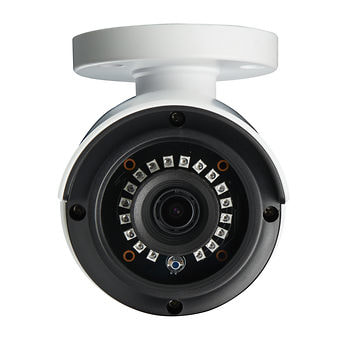
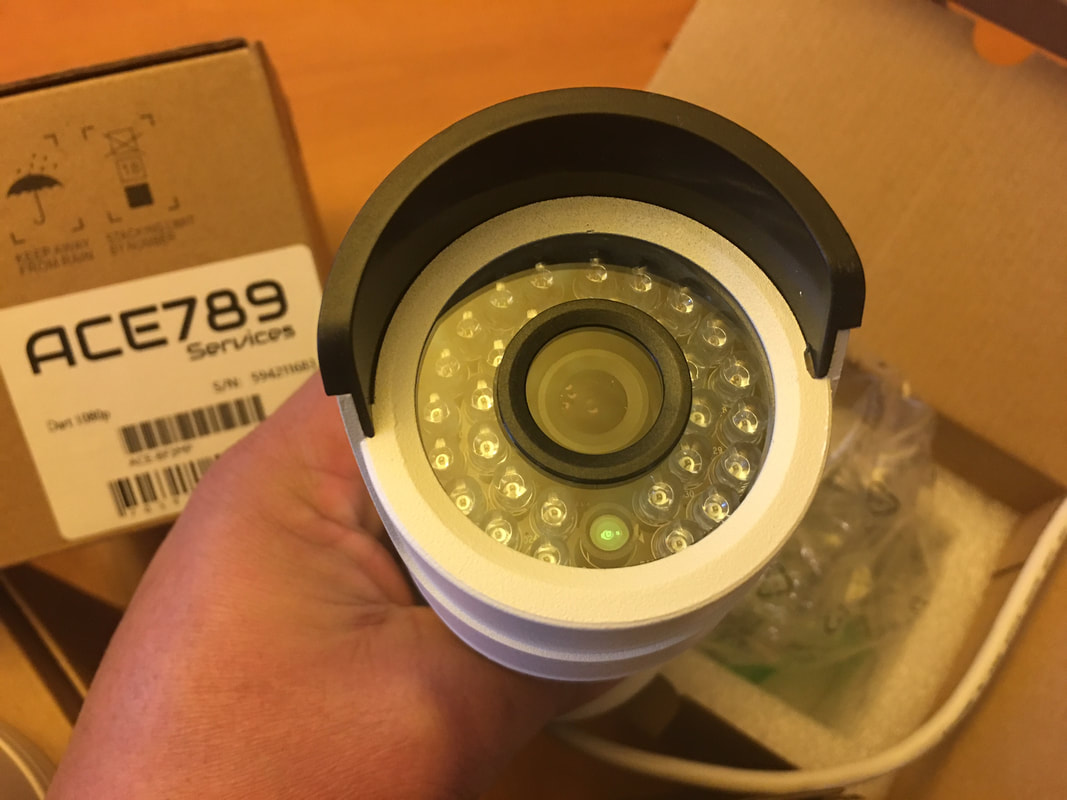
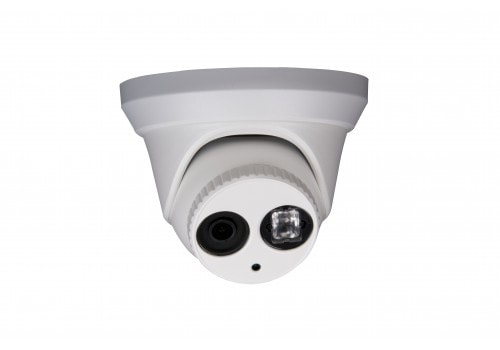
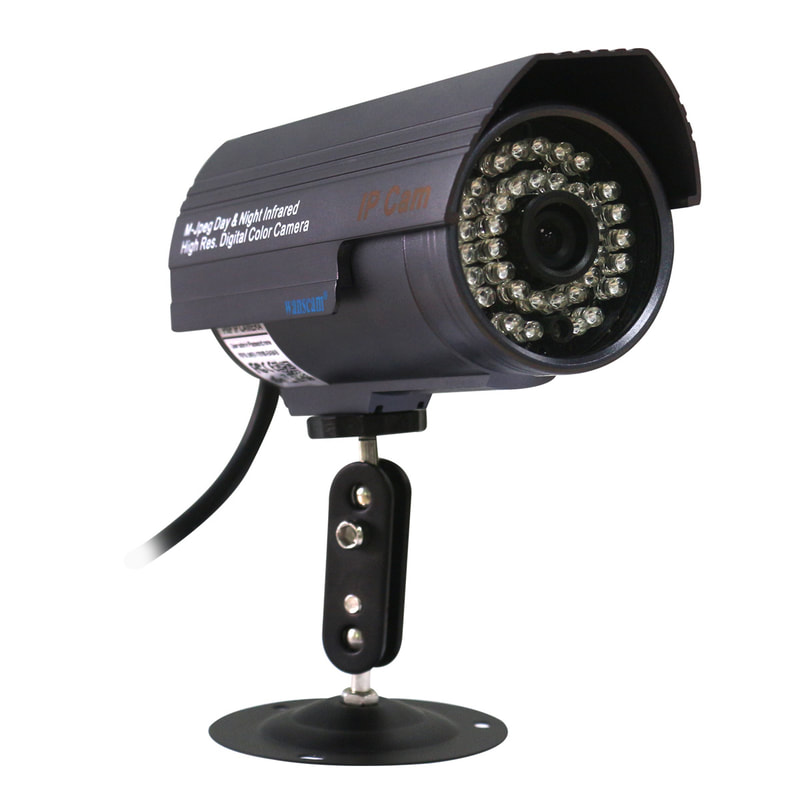
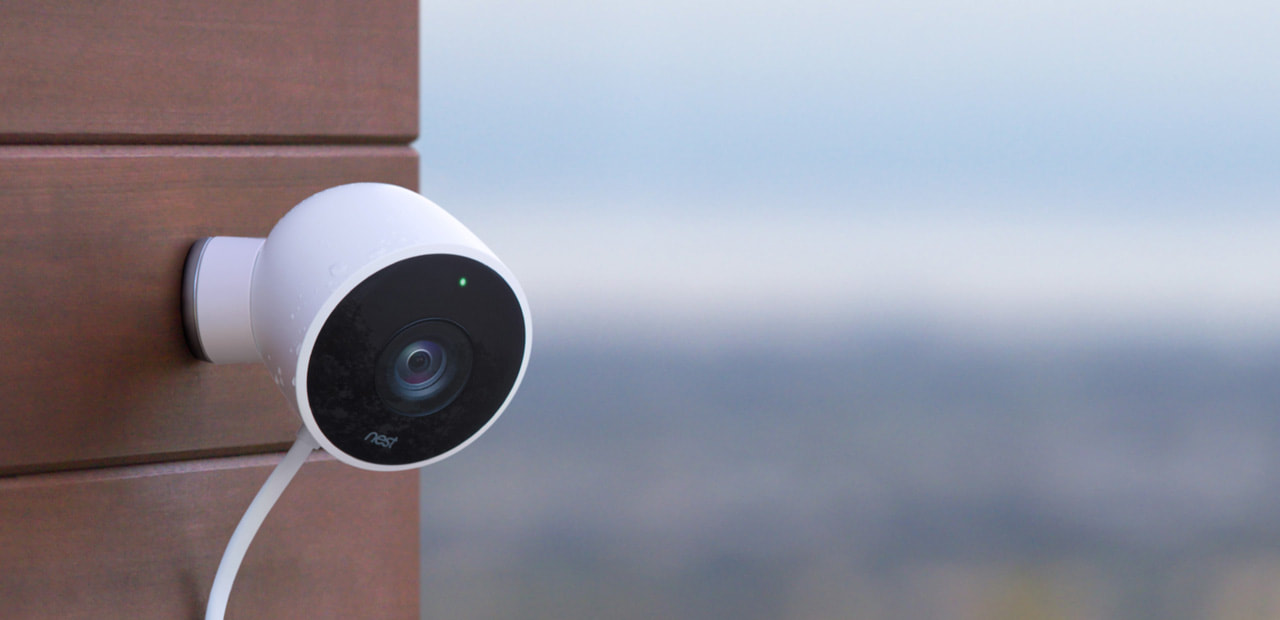
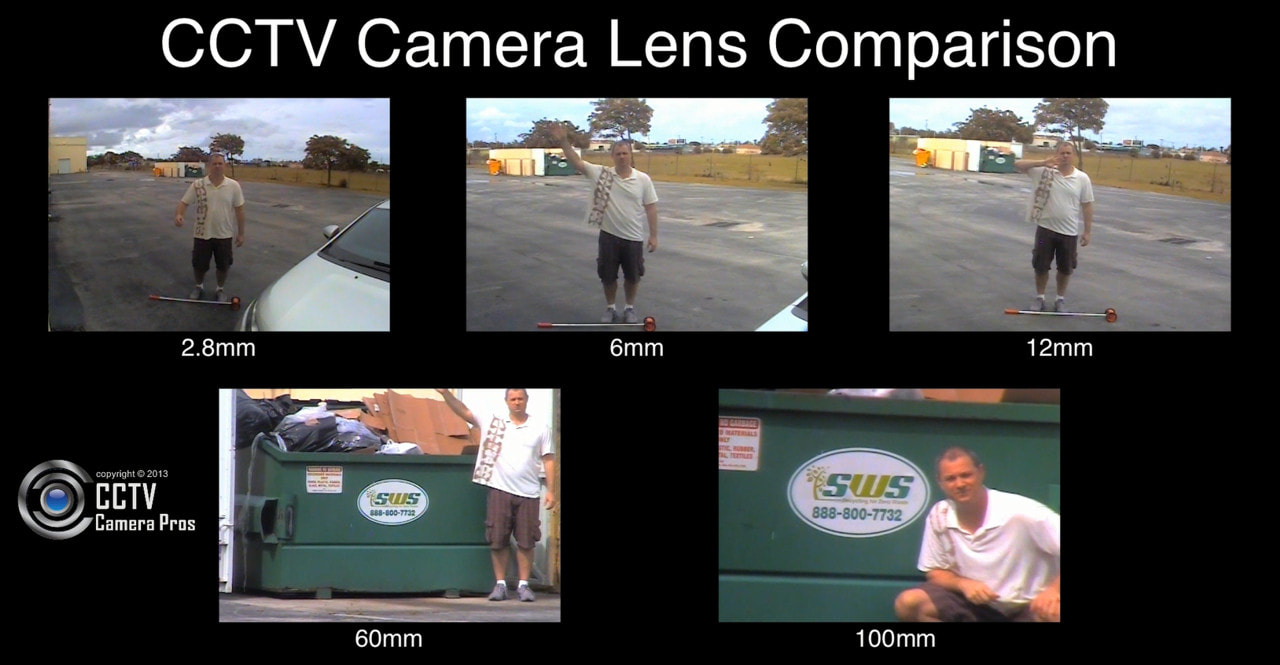
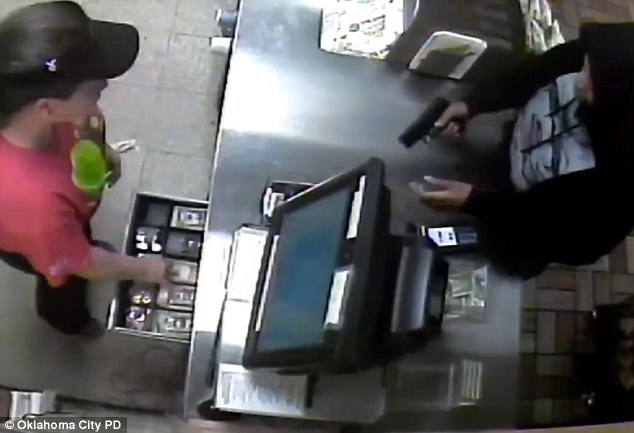
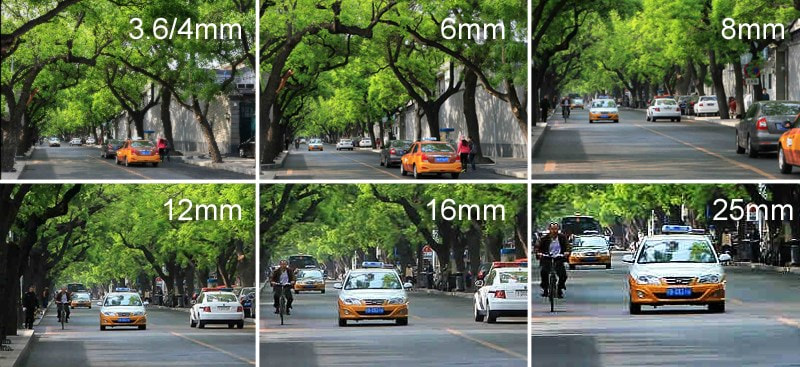
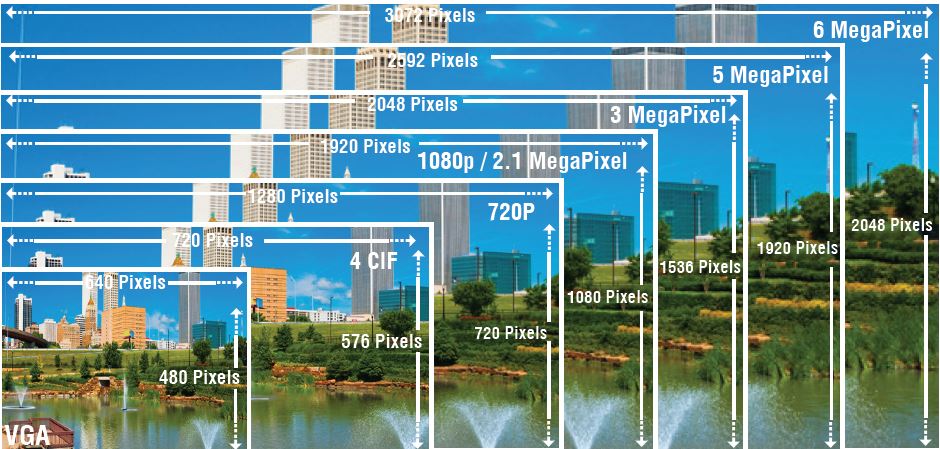
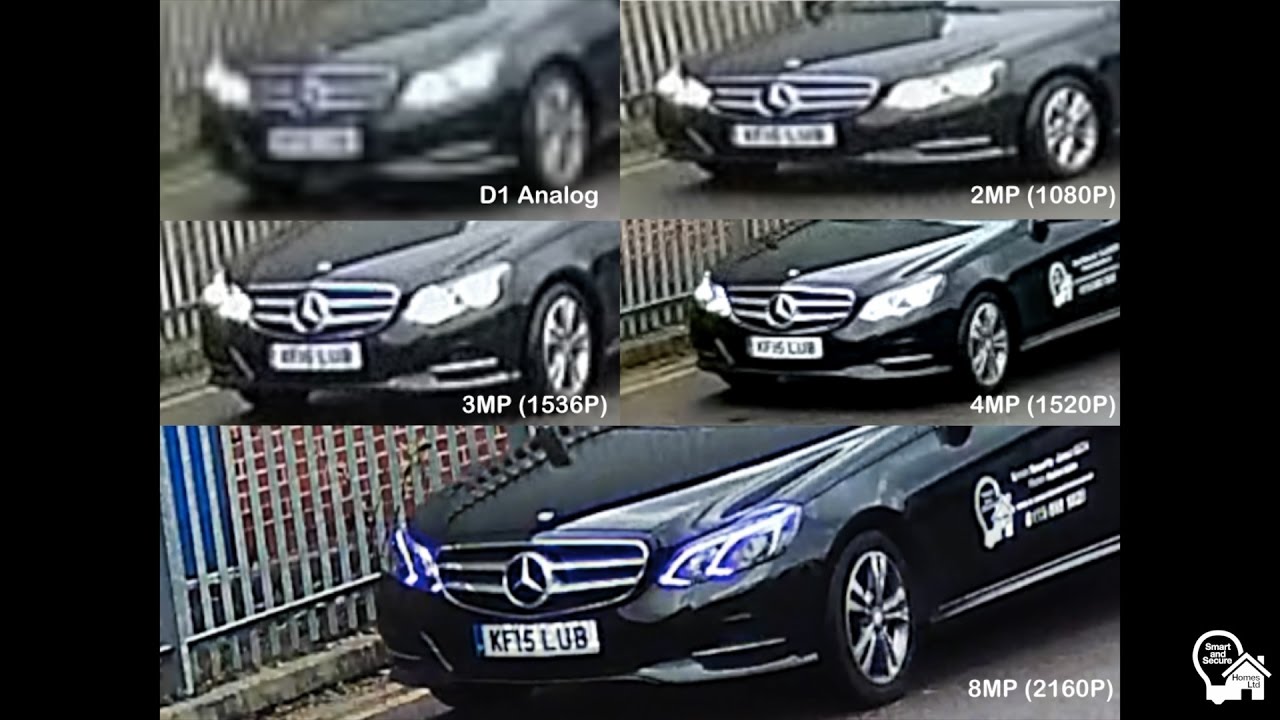
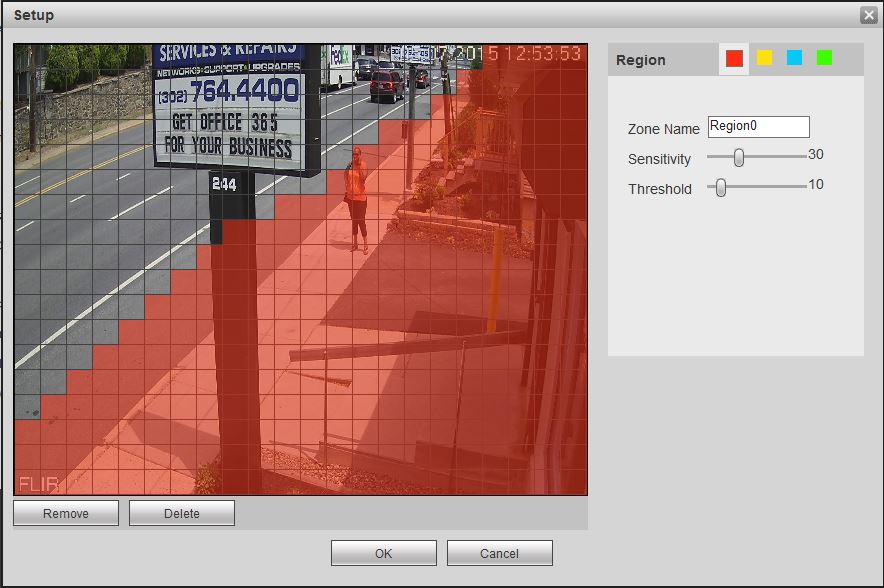
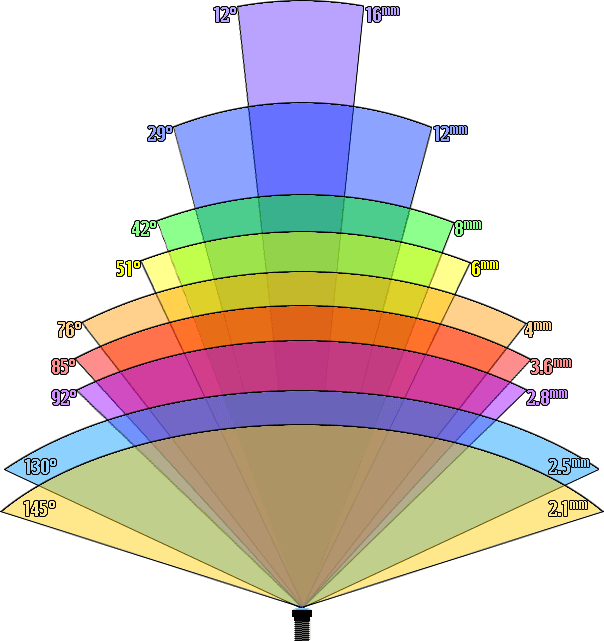
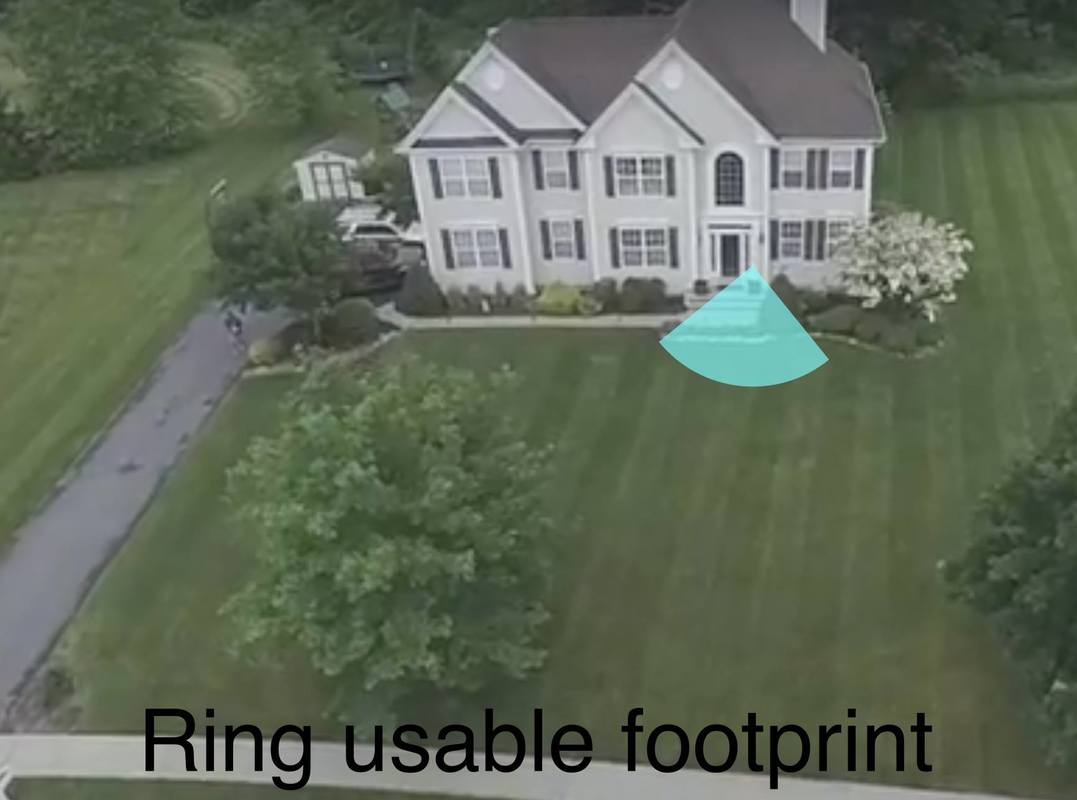
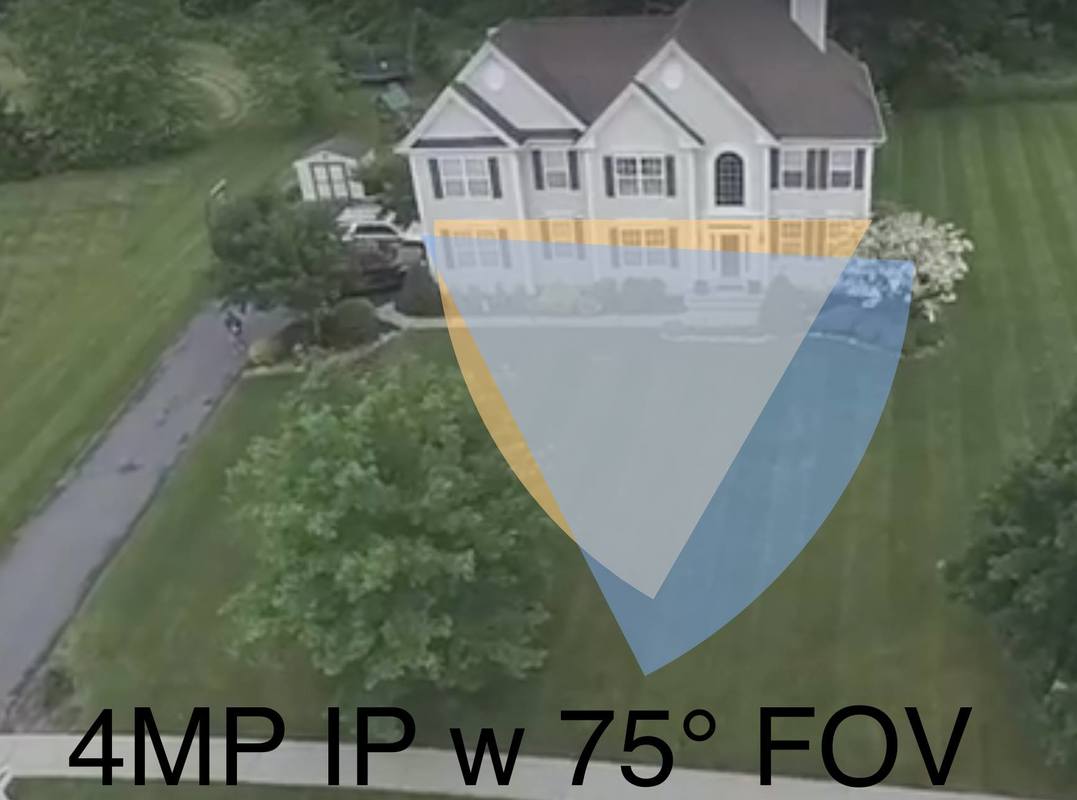
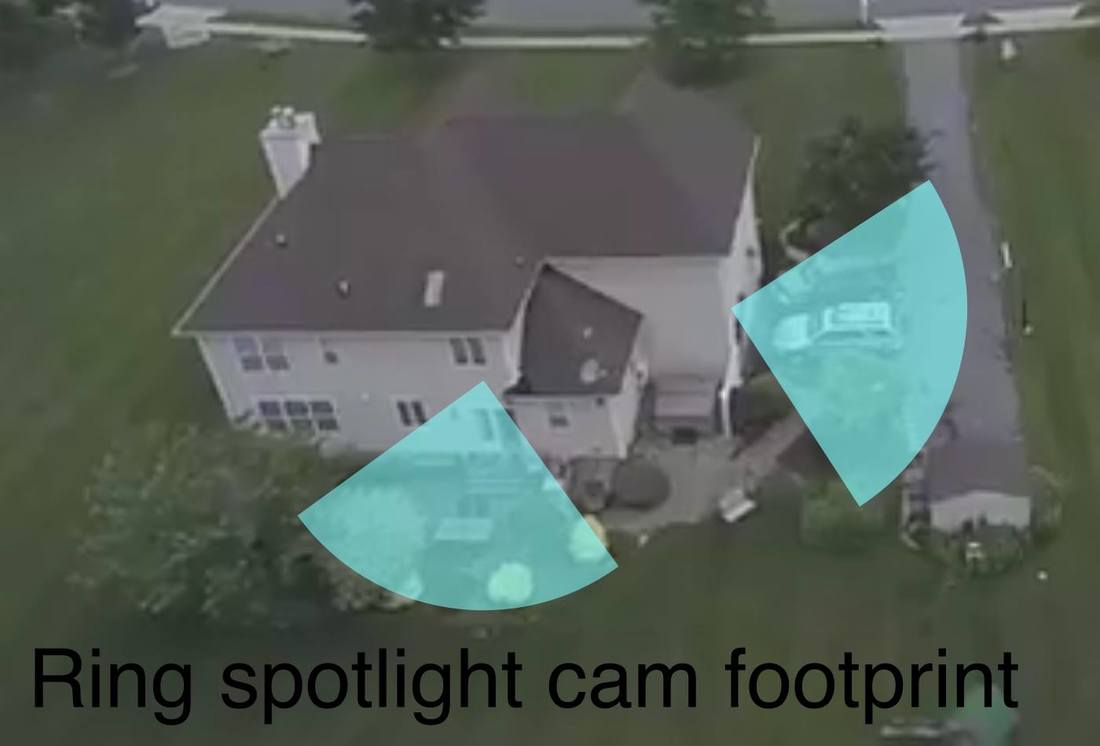
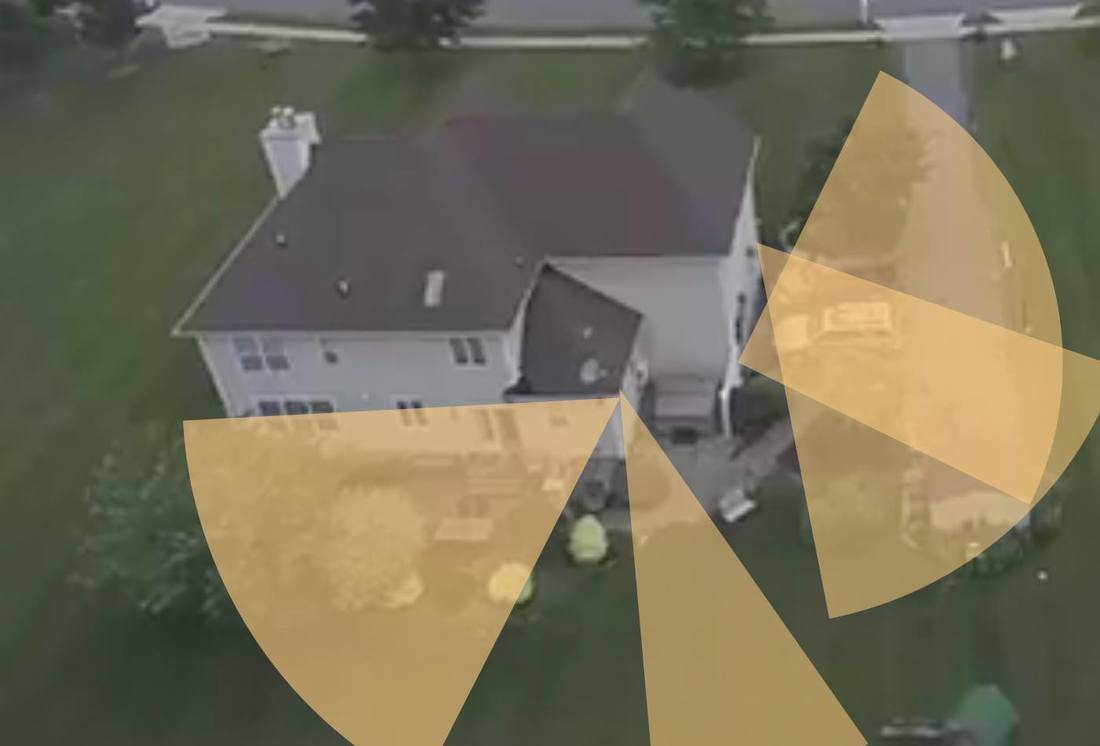
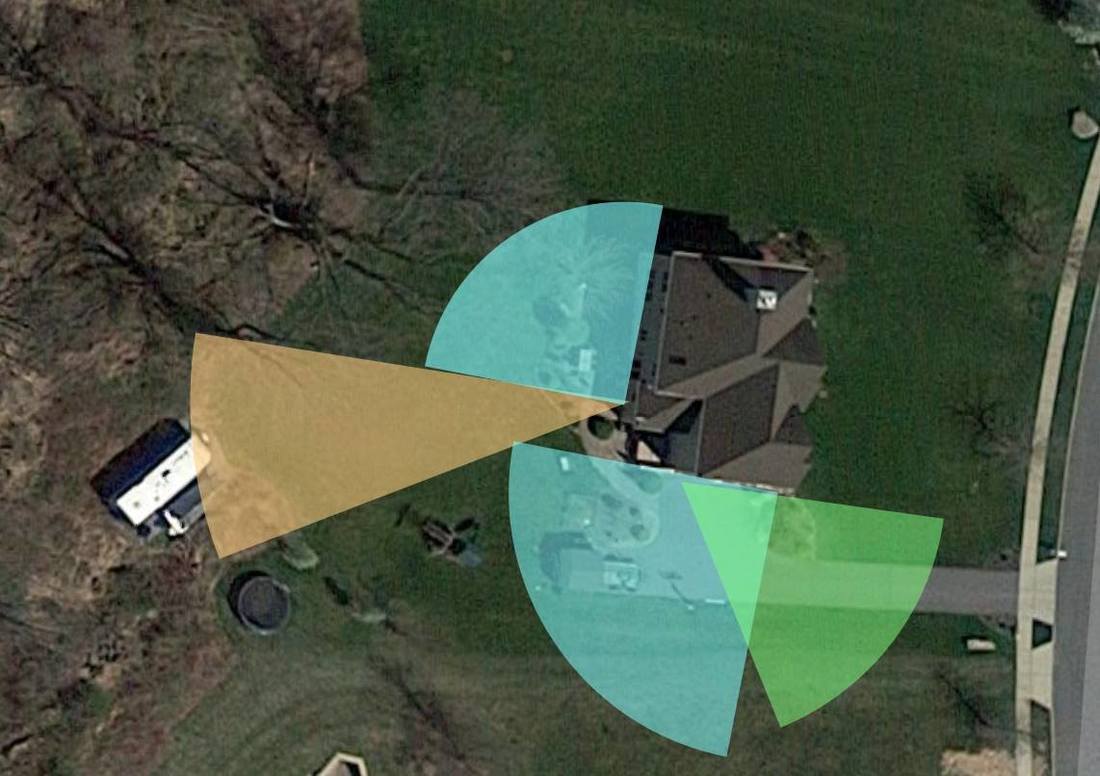
 RSS Feed
RSS Feed